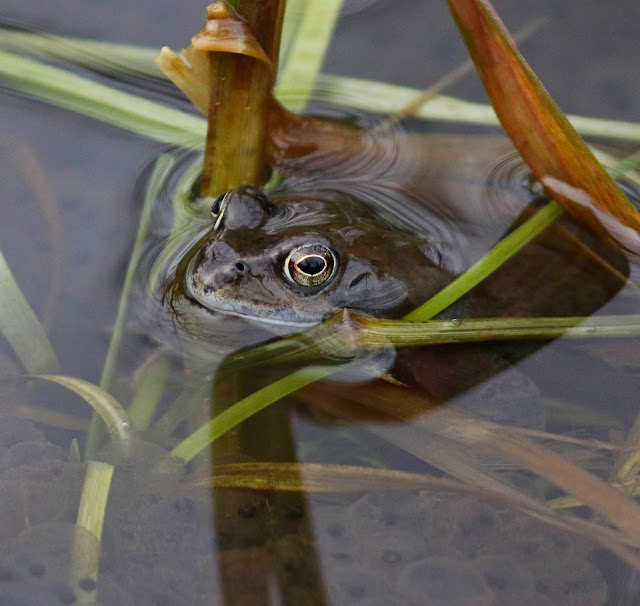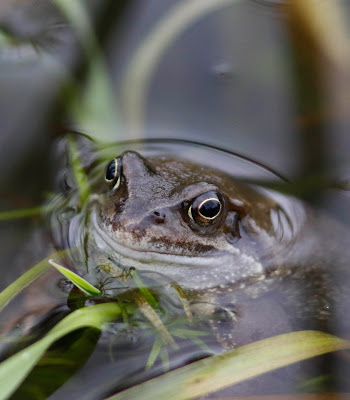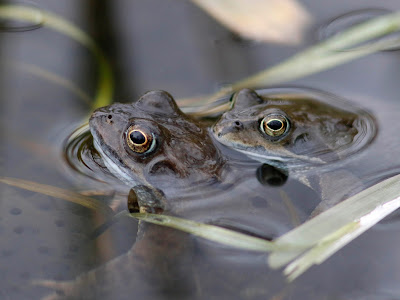Today I decided to forgo my daily visit to Farmoor Reservoir and took myself to another part of Oxford to seek out a favourite amphibian of mine, the Common Frog, which is found throughout Europe, extending as far north as Scandinavia and east to the Urals of Russia. The furthest west it can be found is Ireland.
For me it is still a notable event when I encounter a frog, which is not surprising as frogs maintain a very low profile except when gathering to mate, for they have many predators, such as herons, ducks, crows, gulls and even Weasels, Stoats, Badgers and Otters will eat them. Many others fall victim at mating time to cars on our roads, as they make their way to their traditional breeding ponds. They are not endangered as of yet but their numbers are declining due to habitat loss and a parasitic fungus which is deadly to both them and other amphibian species worldwide and is a growing concern with regard to their future welfare.
You can imagine my enthusiasm when Mark, a birding colleague who I met on Otmoor last weekend very kindly gave me directions to where I could find a large number of breeding frogs and today, a half hour drive from my home, found me parking the car at the bottom of a housing estate on a steep hill and taking a track further downwards through woodland to where a stream ran in the bottom of a small wooded valley, part of which is now a local nature reserve.
 |
| A pond full of frog spawn |
 |
| The pond favoured by the frogs on my visit. The frog spawn can be seen bottom centre of the image |
Their courting is hardly subtle, no formal introductions or elaborate foreplay forms any part of the frog's amorous repertoire. Accompanied by a constant croaking from 'the choir' of unattached males, their vocalisations sounding like a distant motorcycle, they would sit in the water unmoving and then suddenly become active and blunder amongst the already laid spawn, searching for an unmated female or trying to dislodge a male already clasped to the back of a female. Their movements were spasmodic and for long spells they lay in the water, immobile, with just their heads protruding like miniature gargoyles above the surface.
Any movement from another frog and especially a mated pair seemed to be sensed, possibly by the slight vibrations transmitted through the water, and it would immediately attract any nearby frog to it. The way the frogs clambered amongst the spawn, was vaguely pornographic as the jelly like coating slimed over their bodies while they wrestled with each other or endeavoured to dislodge a lucky male already clinging in tight embrace to the back of a female.
Nothing could dissuade the other frogs from endlessly trying to muscle in on any happy couple in the act of procreation, with sometimes three, four and even five suitors pestering a mating pair but usually the male that was already attached to the female managed to kick away any rivals with its back feet and somehow, despite all the interference, the business got done.
The small corner of the pond with the spawn seemed to be the favoured area and all the frogs made for here, presumably as they knew this was where the females preferred to discharge their spawn, which the male, clinging to her back, fertilises with his sperm as it is laid. I estimated there were between fifty to sixty frogs in this one small pond and their swelling white throats stood out against the dark water as they croaked their passion and ardour, which I am told allows the female to discern which male has the loudest and longest croak and would get the chance to jump on and have his froggy way.
Frogs can lighten and darken their skin to blend with their surroundings and during the mating season the male frog turns greyish blue and its throat greyish white while the slightly larger female is more colourful especially on her throat and belly.
Fortunately, this morning only one or two people came along the boardwalk although it is an obviously popular area to walk in, so I was able to sit quietly and undisturbed, listening to and watching the frogs. The breeding season for frogs is mainly from March to April and typically this congregation will all be over in a matter of days, as such a closely packed gathering makes the frogs even more vulnerable than usual. Not that the frogs seem to care as they abandon all caution in their desire to mate. The females will lay their eggs and leave the shallow pond immediately to seek out those hidden damp places in which to hide and the males will remain on the chance of finding another unmated female but once they realise there are no more females they will do likewise.Outside of the breeding season frogs have solitary lives eating insects, worms, spiders and wood lice and in the worst of winter they hibernate.
 |
| Frogs amongst the spawn |
I have only ever seen such a large gathering of frogs once before. It was in Shetland, a few years ago when I twitched a Tengmalm's Owl in some landscaped gardens near Lerwick and where we discovered there was an artificial pond full of frogs. Indeed the frogs were so abundant, not only in the pond but all around in the grass as they made their way to the pond, it was almost as exciting as seeing the very rare owl. There were hundreds of frogs everywhere and you had to be careful not to tread on them. However the fifty or so I encountered today was not a bad substitute and the outskirts of Oxford is a might less distant to travel to than Shetland!
Frogs are not fussy where they lay their eggs, even a small garden pond will often be blessed with frog spawn. I put in a small pond in my garden last summer and earlier this month was delighted to find a mass of spawn in the pond. However I never saw any frog in the pond so they must have been very quick, laying the spawn overnight and then departing.
I spent almost three innocent hours watching the frogs. It was constant theatre as they muscled around and softly croaked the morning away, often almost enveloped in the spawn as they blundered through it with only one thing in mind. A Chiffchaff, stimulated by the emerging sunshine sang from high in a willow tree as the frogs sat in the water and reeds. Spring is here at last.
What better way to spend a few hours?























No comments:
Post a Comment